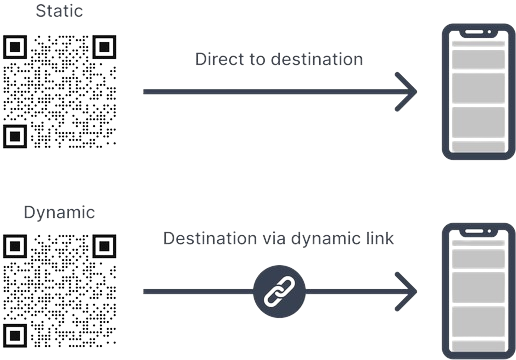Have you ever wondered why manufacturers start putting QR codes on their products? QR codes, those small, black-and-white squares you see on packages, labels, and advertisements, are becoming more and more common. They are easy to scan with a smartphone, and they can hold a lot of information.
What Are QR Codes?
QR stands for Quick Response. QR codes are a type of barcode that can be read quickly by a digital device like a smartphone. But there are two types of common QR codes that manufacturers usually use such as
Static Barcode & Dynamic Barcode.
What are the differences between Static Barcode and Dynamic Barcode?

Among the types of QR codes,
static QR codes are particularly prominent due to their simplicity, ease of use, and wide range of applications.
Static QR codes are a type of QR code where the encoded information is fixed and cannot be changed once generated. They store data such as URLs, text, contact information, or other static data directly within the QR code's matrix. Unlike
dynamic QR codes, which allow for the updating of the embedded information and tracking of scanning activity, static QR codes are immutable.
Limitations of Static QR Codes
Despite their advantages,
static QR codes have several limitations. The most significant drawback is their immutability. Once a
static QR code is created, the embedded information cannot be changed. This inflexibility can be problematic if the information needs to be updated or corrected. For example, if a URL embedded in a
static QR code changes, the code becomes obsolete, and a new one must be generated and redistributed.
Another limitation is the lack of tracking capabilities.
Static QR codes do not provide analytics on how often or where they are scanned. This lack of data makes it challenging for businesses and marketers to measure the effectiveness of their QR code campaigns and make informed decisions based on user interaction.
While
dynamic QR codes differ from
static QR codes in that the information they point to can be changed after the QR code has been generated. Instead of storing the data directly within the QR code,
dynamic QR codes contain a short URL that redirects to the desired content. This URL can be edited, allowing the destination data to be updated without altering the QR code itself. This flexibility makes
dynamic QR codes highly versatile and suitable for a wide range of applications.
Applications of Dynamic QR Codes
The applications of
dynamic QR codes are vast and varied across different sectors. In marketing,
dynamic QR codes are used to link to promotional content, track the success of advertising campaigns, and gather customer feedback. Marketers can change the destination of the QR code to reflect different promotions over time, maximizing the return on investment for printed materials.
In the retail industry,
dynamic QR codes enhance the shopping experience by providing customers with additional product information, reviews, and special offers. Retailers can update the linked content to reflect the latest promotions or seasonal sales, ensuring that the information is always current.
.png)
Impact in Today's Digital Environment
Dynamic QR codes are now a key part of modern digital strategies. They help connect offline and online worlds easily and flexibly. Because they can be updated and tracked in real-time, they are very useful for marketers, teachers, and event planners. More people are using them because smartphones can scan QR codes easily.
The COVID-19 pandemic has shown how important QR codes are for contactless interactions.
Dynamic QR codes have been widely used for health and safety purposes, like digital menus, vaccination records, and contact tracing. Since they can be updated, they keep the information current and correct as rules change.
As technology continues to advance, dynamic QR codes are likely to remain a crucial component of the digital landscape, enhancing connectivity and interactivity in our increasingly digital world.